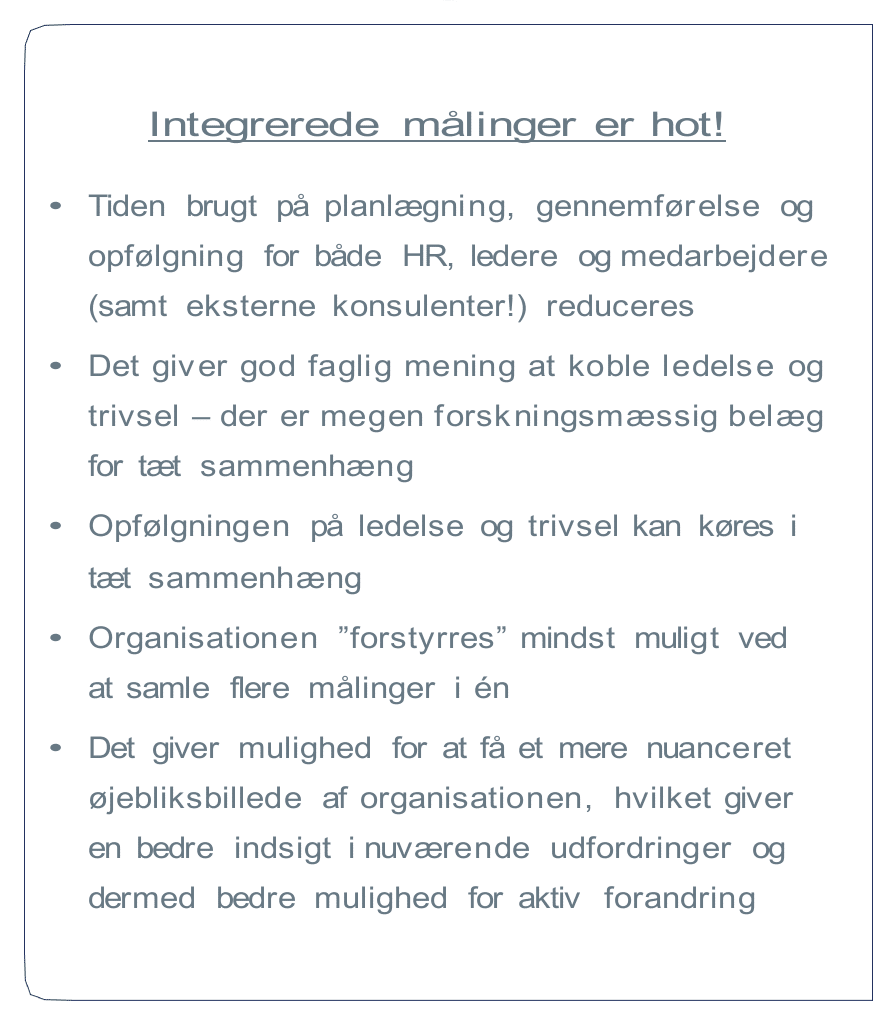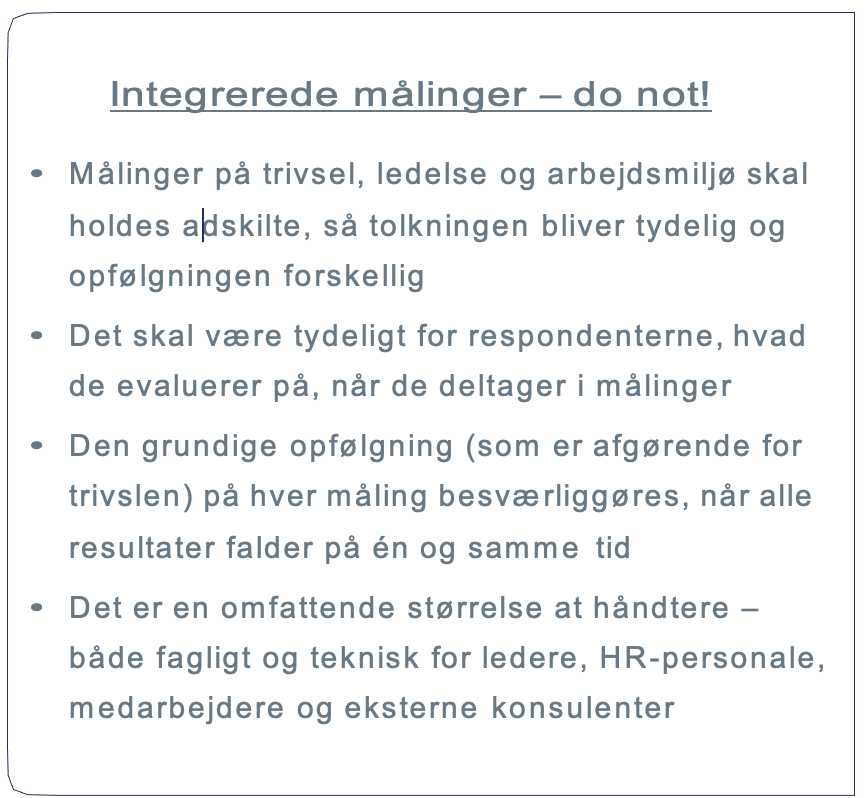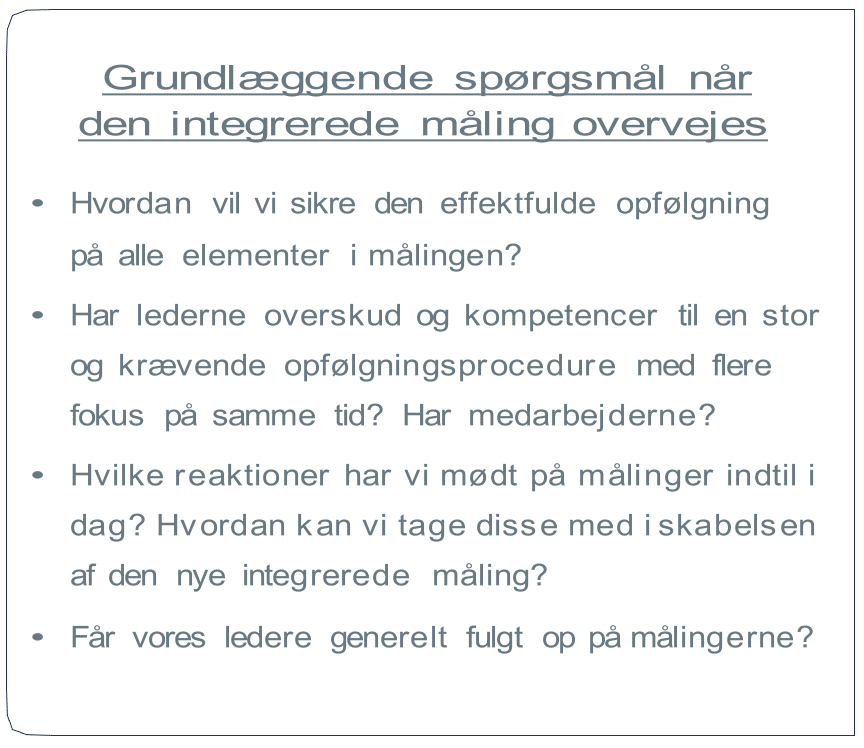Integrated metrics are starting to enter the market for management evaluations, well-being assessments and workplace assessments, where they are typically referred to as 3in1 and 2in1. For the same reason, professionals are crying out for experiences and recommendations in this relatively new area. Unfortunately, research in the field is sparse (close to non-existent), which is why I would like to start the discussion about their pros and cons, while also sharing the experiences from the integrated measurements I have been involved in developing.
Integrated metrics are hot!
Overall, there are clear professional connections between management, wellbeing and the psychological work environment, and it makes sense to link them in any case - and therefore also natural to coordinate the measurements. All the surveys can have elements of management and well-being in them, which is why there is often overlap, which is tiring for managers and employees when the same management or well-being questions are asked in all surveys.
Each measurement has its own specific purpose. For example, a leadership evaluation is not about whether employees are happy with their manager and workplace, but about how the exercise of leadership promotes collaboration, good results, quality, efficiency, etc. Similarly, a well-being measurement should examine the well-being of the organization. The relationship between these measurements must be discussed and decided so that we don't risk important information about, for example, work environment and well-being drowning in the amount of data about leadership quality - and vice versa. Here are some of the arguments for creating integrated metrics typically:

READ MORE ABOUT OUR EDUCATION
LEAD
offers certification in the development of agile leadership with the development tool The Leader's Versatility Index (LVI)
With a certification, you will be equipped to use LVI in development processes in your organization at the individual, group and organizational level.
Some of the arguments for not doing integrated measurements are typical:
One of the biggest reasons for not doing integrated measurements is that the measurement and especially the follow-up becomes a huge task that you need to be absolutely sure you have the muscle to handle. The thorough and proper follow-up must be ensured in order to avoid dissatisfaction in the organization after such measurements, which becomes logistically difficult. My main point of attention here is that proper follow-up on all elements must be ensured. If this cannot be ensured, an integrated measurement should not be made.

When you conduct integrated measurements
It should be clearly emphasized that integrated measurements are possible and can be done properly. It's just important that the process is structured and that you're ready to put the resources into the measurement that it requires when you're doing a measurement that is two or three times as extensive as the one you usually do. Here I have listed some of the points of attention that have become clear to me in my work with integrated measurement:
- Focus on the purpose of the survey and prioritize. I often come across very ambitious integrated surveys that leave a lot of questions unanswered - which, unsurprisingly, take a long time for respondents to answer. Focusing on the purpose of the survey is crucial in all surveys, but when the surveys are aggregated, prioritizing the number of questions also becomes crucial. What is the most important thing the organization gets out of this wellbeing survey? On leadership? On workplace safety? What should the management, the individual manager/employee and HR get out of the survey?
- Ensure clarity throughout the survey so respondents always know which survey they are providing input for.
- Structure the follow-up to ensure good follow-up on all two/three measurements. Plan a cadence where it is clear to both managers and employees when and how to follow up on wellbeing, work environment and leadership. A follow-up process could, for example, be structured in several rounds, where the first part of the process could be:
- The Executive Board gets insight into the overall performance of the entire organization
- Leaders gain insight into the overall results of the organization and are equipped to read all reports and interpret their own results
- Each manager invites their employees/subordinate managers to a meeting about wellbeing, where they get an insight into the results and discuss how the area can work together to improve wellbeing - work on what is not working and continue with what is working.
- The follow-up on the management evaluation can either be taken as the last part of the wellbeing meeting or in a separate meeting. The important thing here is that it is clear to the participants in the meeting what belongs to which metric. At the meeting, the manager acknowledges the feedback and gets elaborations on how they can become an even better manager and how managers and employees together can create better conditions for good management, which in turn affects wellbeing in the workplace.
- Follow-up on the workplace assessment is done in a separate meeting where the results are discussed with the employees and a concrete action plan is created.
- After these meetings, it is important that concrete agreements are made for the further work in the follow-up / initiatives, but also that the "next steps" are clarified so that employees know when they next need to follow up on well-being, management or WPA.
Basic considerations and looking at your own organization when making the choice:
To ensure the best conditions for a good start to the new survey in terms of engagement and response rate, it is crucial that the last survey was conducted professionally and with good follow-up afterwards.




